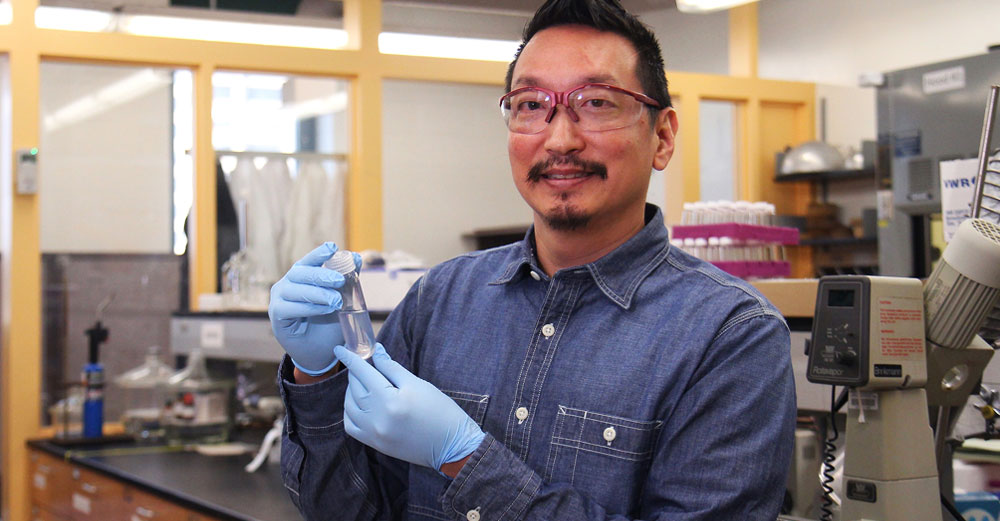
Cancer drugs, even those that are delivered directly to cancer cells, often are released somewhere in the vicinity of diseased cells, possibly killing them but almost certainly killing healthy cells in the process. In a “Trojan horse”-style maneuver, Chris Nomura, associate professor of chemistry at the SUNY College of Environmental Science and Forestry, hopes to trick cancer cells into directly ingesting chemotherapeutic drugs so they are destroyed from the inside out, thus reducing damage to normal cells.
“Traditional chemotherapeutic agents make people extremely sick because they don’t specifically target cancer cells,” said Nomura. “We hope that by packaging chemotherapeutic drugs in a concentrated form in a special polymer we can specifically target cancer cells, thus reducing some of the collateral damage associated with traditional chemotherapeutic agents.”
Nomura’s “special polymers” are polyhydroxyalkanoates (PHAs). He and his team have engineered E. coli bacteria to produce these PHAs, which serve as the vehicles—the Trojan horses, if you will—for delivering cancer drugs. The engineered E. coli are capable of creating PHAs which can then be converted into particles of a specific “nano” size—small enough to be ingested by cancer cells, but not so small that they flush straight out of the body through the kidneys.
“By manipulating the metabolism of this organism—in other words, by feeding it different types of fatty acids—we have engineered a strain of E. coli that is capable, for the first time, of producing polymers of specific sizes,” said Nomura. “So if we take a four-carbon fatty acid, like butyric acid, and we feed it to our bacteria, it’ll produce a polymer that has four-carbon repeating units. Conversely, if we take an eight-carbon fatty acid and feed it to the bacteria, it will produce a polymer that has eight-carbon repeating units.” Nomura has applied for a patent for his bacterial strain and its ability to make these PHA polymers.
Next Nomura needed to figure out how to modify the polymer so it would specifically target cancer cells. Ata Pinto, a postdoctoral fellow working in Nomura’s lab, made this leap. He figured out how to attach azides—groups of three nitrogen molecules that can be easily modified to the ends of fatty acids through a process known as “click chemistry.” “Click chemistry allows us to attach molecules together in an instant and under very mild conditions,” said Nomura. Once the researchers fed these azide-containing fatty acids to the bacteria, the resulting PHAs produced by the bacteria contained azide groups as well. These groups can be simply modified with a myriad of molecules capable of targeting a specific receptor on a cancer cell.
With an investment from the SUNY Technology Accelerator Fund, Nomura and his colleagues are collecting preliminary data on these polymers with a goal of making the next big step—developing their cancer-cell-targeting PHA polymers into a drug-delivery platform. “The Technology Accelerator money is absolutely essential for us to reach our goals,” said Nomura. “We think our idea has a lot of promise, and this funding is definitely giving us a great liftoff.”
The team hypothesizes that it can modify the azide groups on the PHA polymers to contain folic acid. “Certain types of breast cancer cells highly overexpress the receptor for folic acid,” said Nomura. “These cells are trying to take in all these extra vitamins, so they can multiply rapidly. We hope to trick them into engulfing our polymer, which contains folic acid as well as a chemotherapeutic agent.”
Once the “Trojan horse” is in place, the team—with help from Juntao Luo, assistant professor of pharmacology at SUNY Upstate Medical University—plans to test the polymer to ensure that it is safe. Luo will examine the effects of the polymer on various healthy cells.
In the meantime, the team has created a company called Alba Solutions LLC through which they can apply for Small Business Innovation Research funds from the U.S. federal government. “We also hope to talk with some potential investors to financially help us generate a higher technology readiness level so the product can either be commercialized directly by us or purchased by a commercialization partner,” said Nomura.
According to Nomura, the polymer he and his team have created is completely novel. “We’re now capable of modifying polymers well beyond what you can achieve in nature,” said Nomura. “It’s pretty amazing, and it has the potential to be life changing.”



